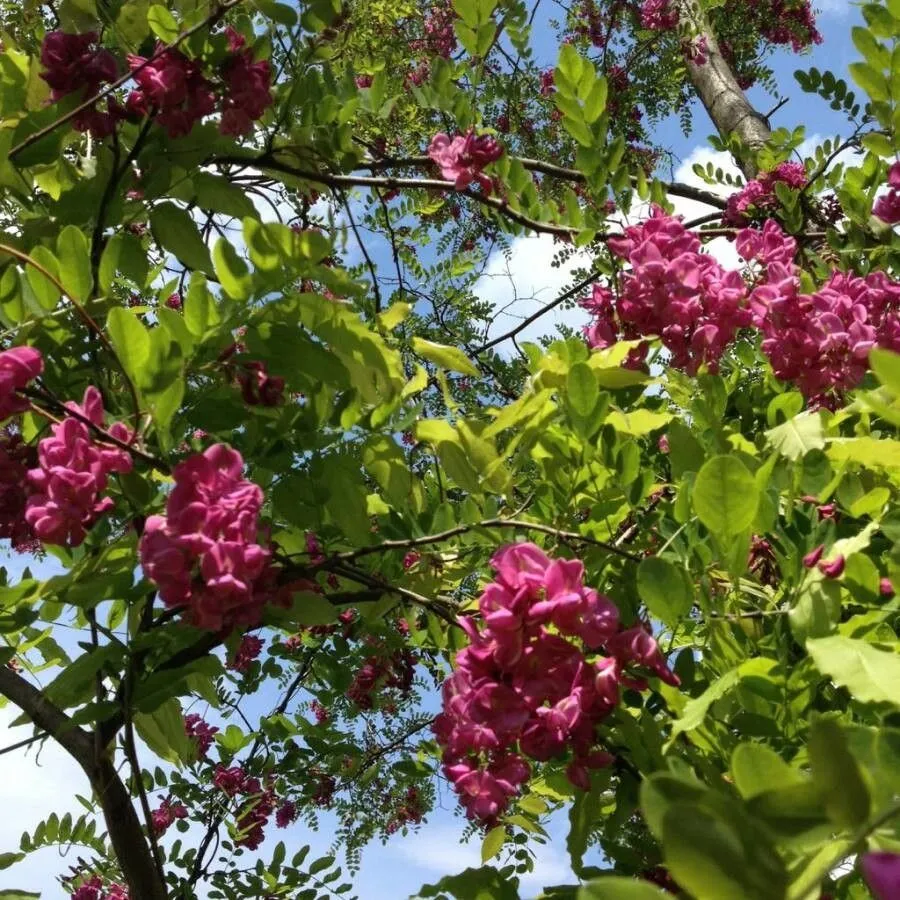
Author: L.
Bibliography: Mant. Pl.: 101 (1767)
Year: 1767
Status: accepted
Rank: species
Genus: Robinia
Vegetable: False
Observations: E. U.S.A.
Moss locust, also known by its scientific name Robinia hispida, is a fascinating plant species native to the eastern United States. Belonging to the Fabaceae family, this species was first described in 1767 by the renowned botanist Carl Linnaeus.
The Moss locust is distinguished by its lovely, rose-pink to purplish flower clusters, which add a splash of color to its native habitats. The plant typically thrives in well-drained soils and can often be found growing in open woodlands, along forest edges, and in other upland habitats where it benefits from ample sunlight.
One of the defining characteristics of Robinia hispida is its woody branches, which are covered in tiny, stiff hairs giving them a distinctive, bristly texture. This unique feature not only gives the plant its common name, Moss locust, but also contributes to its rustic, natural beauty.
Growing up to several feet in height, Robinia hispida spreads by forming colonies through its underground root system, making it an excellent choice for ground cover in natural landscaping projects. Its flowers, which bloom in late spring to early summer, provide an important nectar source for bees and other pollinators, thus playing a crucial role in the local ecosystem.
In addition to its ornamental value and ecological benefits, the Moss locust has adapted well to a variety of environmental conditions. It is relatively hardy and can tolerate drought once established, although it does thrive best in conditions where it receives adequate moisture.
Overall, Robinia hispida or Moss locust stands out as a robust and beautiful member of the pea family, celebrated for its vibrant flowers, distinctive foliage, and significant ecological contributions.
Fra: acacia rose, robinier rose, robinier hispide
Eng: bristly locust, moss locust, rose acacia, rose locust, rose-acacia
Ces: agát srstnatý
Swe: rosenrobinia
En: Moss locust, Rose-acacia, Bristly locust, Rose acacia, Standing sweet pea, Roseacacia, Rose Locust
Az: Sərttüklü ağ akasiya
Zh: 毛洋槐
Cs: Trnovník huňatý, Agát srstnatý
Nl: Rode Regen, Rose Acacia, Ruwe Acacia
Fi: Ruusuvaleakaasia
Fr: Acacia rose, Robinier rose, Robinier hispide
De: Borstige Robinie, Borsten Akazie, Borsten Robinie
He: רובינה זיפית
Hu: Rózsás akác
It: Acacia rosa
Ml: റോബിനിയ ഹിസ്പിഡ
Fa: اقاقیای قرمز
Ru: Робиния щетинистоволосая
Es: Acacia rosa, Acacia rosada
Sv: Rosenrobinia
Taken Apr 25, 2017 by Pep Secem (cc-by-sa)
Taken Dec 12, 2018 by Dieter Wagner (cc-by-sa)
Taken May 11, 2018 by Dieter Wagner (cc-by-sa)
Taken May 11, 2018 by Dieter Wagner (cc-by-sa)
Taken Dec 12, 2018 by Dieter Wagner (cc-by-sa)
Taken Jul 12, 2022 by Fabrice Rubio (cc-by-sa)
Taken May 2, 2021 by Afaria (cc-by-sa)
Taken May 3, 2021 by AJ B. (cc-by-sa)
Taken May 11, 2018 by Dieter Wagner (cc-by-sa)
Taken May 11, 2018 by Dieter Wagner (cc-by-sa)
Taken May 8, 2022 by jesus sanz de las heras (cc-by-sa)
Taken May 14, 2019 by Renaud Brochiero (cc-by-sa)
Taken Jul 17, 2020 by MARC BEZIN (cc-by-sa)
Taken Nov 11, 2022 by siberiano corelli (cc-by-sa)
Taken May 24, 2020 by Jean-Marie Frenoux (cc-by-sa)
Taken Jul 12, 2022 by Fabrice Rubio (cc-by-sa)
Taken May 2, 2021 by Afaria (cc-by-sa)
Taken Jun 6, 2021 by Jarek-SRT (cc-by-sa)
Taken Jul 22, 2022 by Oğuzhan (cc-by-sa)
Taken May 22, 2021 by Jennifer Jennifer (cc-by-sa)
Taken Jun 17, 2022 by Jeff Smith (cc-by-sa)
Taken Jul 13, 2020 by moonanimal (cc-by-sa)
Taken Aug 15, 2007 by Photoflora – Jean-Luc TASSET (©)
Taken Jul 24, 2021 by Paul Backus (cc-by-sa)
Taken Aug 16, 2022 by antonia jacob (cc-by-sa)
Taken Jul 23, 2022 by per (cc-by-sa)
Taken May 15, 2011 by Photoflora – Jean-Luc TASSET (©)
Taken May 15, 2007 by Photoflora – Jean-Luc TASSET (©)
Taken May 15, 2007 by Photoflora – Jean-Luc TASSET (©)
Taken Apr 21, 2012 by EOL − Ron Thomas (cc-by-nc-sa)
© copyright of the Board of Trustees of the Royal Botanic Gardens, Kew.
Growth habit>: Tree, Shrub
Family: Myrtaceae Author: (F.Muell.) K.D.Hill & L.A.S.Johnson Bibliography: Telopea 6: 402 (1995) Year: 1995 Status:…
Family: Rubiaceae Author: Pierre ex A.Froehner Bibliography: Notizbl. Bot. Gart. Berlin-Dahlem 1: 237 (1897) Year:…
Family: Sapindaceae Author: Koidz. Bibliography: J. Coll. Sci. Imp. Univ. Tokyo 32(1): 38 (1911) Year:…
Family: Asteraceae Author: A.Gray Bibliography: Pacif. Railr. Rep.: 107 (1857) Year: 1857 Status: accepted Rank:…
Family: Fabaceae Author: Medik. Bibliography: Vorles. Churpfälz. Phys.-Ökon. Ges. 2: 398 (1787) Year: 1787 Status:…
Family: Aspleniaceae Author: (Cav.) Alston Bibliography: Bull. Misc. Inform. Kew 1932: 309 (1932) Year: 1932…